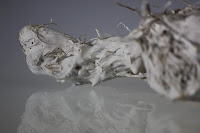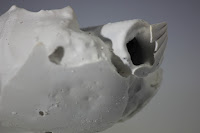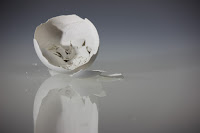




This experiment was simply a balloon filled with plaster and then air. The balloon was blown up too large and as a result the plaster set too thin and crumbled too easily.





This experiment involved a small dowel being placed inside of a balloon and then filled with plaster. There was not much air in the balloon and so the plaster has set in one piece surrounding the dowel. The balloon has left some interesting stretch marks in the plaster


In this experiment I filled a balloon with a metal dog-tag, plaster, and some air, in the hope that I would be left with a piece of metal inside of a fragile egg shape that has the potential to smash it from the inside. The plaster stuck to the metal and didn't form fully across the balloons surface.



This simple balloon mould was formed by filling the balloon with plaster and tying it up. It shows the original shape of the balloon moulds and creates a comparison for the other experiments.



Instead of using a dowel I thought a thick rope could hold a balloon apart for plaster to spread around. The Rope was frayed and the plaster clung to all of the crevices of the rope. The balloon popped and send plaster all over me causing a lack of formation from the balloon and instead just a hairy glob.

The firework was merely surrounded by plaster. The idea behind this is that it will smash when lit. Realistically this won't be the case as the plaster is not covering the hole where the firework ignites. However it will still be a fun experiment outside of university hours.


In this experiment whilst filling up the balloon with plaster and then a breath of air, I blew too much air in and the plaster leaked into the pocket of air within the hose, spoiling the entire piece.




This experiment was one of my earlier attempts. I used a decent amount of liquid plaster, but blew a lot of air into the balloon. On top of this I did not rotate the balloon much as the plaster set. The bottom of the shape is a solid lump of plaster, but the top shattered into the middle of it when I popped the balloon. Disappointing, yes; but also beautifully fragile. even the broken pieces portray this beauty.





This experiment was done with a strong piece of black tubing. It seems that the plaster has leaked into the center of the pipe drastically changing the shape from its intended look. However, we do experience some interesting breaks lumps, bumps, and imprints made by the balloon knot.

This experiment was created by using a small piece of plastic hose and inserting it into a balloon. Plaster was poured in, and then air blown into it. When I went to pour the plaster for this piece the plaster had already hardened considerably. Even though I rotated the balloon a lot the plaster had already formed mostly in one spot. The small layer of plaster attached to the rest of the balloon shattered as it was released.


For this experiment I was again using the plastic hose, this time however I didn't blow much air into the balloon. As a result it is mostly one solid piece.





For this experiment I created a cross joint by cutting into two pieces of dowel and slotting them together. Whilst separated I slipped them into the balloon which I filled with air, next I fit the two dowels back together to form the cross. I released the air until the cross fitted in place against the sides of the balloon. This was then filled with plaster and a breath of air, however I must've neglected it as the plaster didn't spread across all surfaces of the balloon as it would if I had turned it regularly.


This experiment connected the plaster to a natural material, drift wood. Using it much the same way as other materials I was able to prop open the balloon and then fill it with plaster. Next I blew some air into it and then continued to rotate it in order to evenly spread the plaster. This was successful, with only a few small breaks occuring.


This experiment was the first one I had done with plastic hose, I was a bit dubious of the hose at first as I had no idea that it could fit inside the balloon without the balloon breaking, however as I like to say 'Where there is will there is way.' So I managed to stretch a balloon over it. I like the effect of having a tunnel through the middle of my object. I quite like the idea that a things centre of balance isn't a physical spot, and this illustrates that nicely. Even though this piece was not hollow I knew I wanted to continue on with it.

My first successful object + balloon experiment. The idea came from me thinking 'Could I change the shape of a balloon by stretching it on the inside' and sure enough I was able to produce this brilliant shape. The shape was more intact but over the course of a week it has gradually fallen apart. An interesting trait.

For this experiment I used a medium length piece of hose, I put it into a balloon with plaster and a breath of air however the plaster was already starting to set. When trying to spread the plaster evenly There was minimal movement as most of the plaster had set fast. This is another good example of the hose tunnelling through the object, yet apart from that it is a fairly boring shape.


This experiment was also done with hose. Most of the plaster formed in one spot, and the little amount that did spread around the balloon wasn't strong enough to hold itself in place when the balloon was removed. Smash! and it was gone, leaving me with a blob of plaster with a hose sitting on it. Interestingly, some plaster made its way into the hose yet didn't completely seal either end.

This experiment was purely plaster, balloon, and air. No other objects. I sat for half an hour turning this as it slowly set around the balloon. Creating a perfectly smooth egg shape; however, this process mixes the plaster as it dries, this results in plaster that easily crumbles. Once a hole was made in the balloon I left it for another day to dry the inside out before attempting to completely remove it for fear of smashing the whole thing.

In this experiment I again used a piece of drift wood. This piece was bent, and made for an interesting shape. With this shape came an uneven distribution of plaster (coupled with my lack of turning it.) When set and open the fragile pieces smashed off leaving me with a spinning top looking shape.








































No comments:
Post a Comment